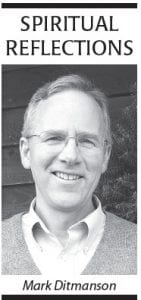Recently I was running copies of a Sunday worship bulletin on the high-speed risograph in our church office. It is a big beast of a machine made by Ricoh, and it is fast and wonderfully efficient. I have learned that the technology behind this machine is roughly the same as the old mimeographs I remember from years ago. This one is just completely automated and mechanized.
After I pushed the print button, the inked drum was wrapped with the master and soon began to roll and 150 copies shot out of the machine with a steady beat. The sound of it had a hypnotic effect and in that moment I was taken back in memory to a quiet, peaceful, and slow-paced office in Japan.
Years ago (1978) I was hired by the American Lutheran Church as a conversational English teacher and was stationed in Matsuyama, Japan where I held my classes in a Japanese Lutheran congregation’s educational wing. My pastor, Shigeru Kurihara, used a very old form of mimeograph. When he wrote and published the weekly worship bulletin he laid out a wax covered sheet of paper and with a special stylus, inscribed by hand the Chinese characters and the Japanese syllabary to create the text. Then he placed the waxed sheet on an inky screen, placed a clean sheet of paper beneath it, and with a small roller he would roll ink over his inscriptions producing one copy at a time.
We could talk and sip green tea through much of the procedure because it took time. It is a cherished memory of getting to know my sensei (Japanese for teacher) as I watched the great care he put into the handproduced copies.
That was a long time ago. Now we live at a time when even this high-speed machine in our office is “old school.” It is too connected with a paper culture and more people find themselves turning to digital resources. Now we find instant, abbreviated, and wireless means of communication are becoming the norm. In this age of instant communication and transactions in “real time,” when decisions seem to be made with a click and deals are closed in a blink of an eye, however, there is still need for us to slow up the pace and attend to matters of the heart and soul the old way.
Not that I would want to go back to handwritten bulletins or do away with the real convenience and greater efficiency of newer technology. But as we all know, life is about more than convenience and efficiency. There is something to be valued and preserved in the process of taking time.
Another favorite memory is how Pastor Kurihara would produce posters to hang outside his church announcing the weekly sermon title. He did so by spreading his paper on the rice mat floor and with a brush and inkpot and steady hand, write the Chinese characters. People on the street would stop to read his announcements and invariably they would move their own hands as if they held an inked brush replicating his brush strokes as they admired his writing. In Japan the calligraphy of Chinese characters is a valued art form. They could see he gave himself to this art form, and therefore they could read into his message not only the content of his sermon, but also the integrity of his heart. His posters sparked deep conversations about art, tradition, and the message of Christ. It was a rich medium. That takes time.
I believe it is worthwhile to advocate for a part of our humanness that is enriched by slowing up to savor the moment. I apply this very often to the reading of our Holy Scriptures. It is good to turn aside from the busy-ness of life to notice the careful choice of words Matthew or John use in the Gospels; we can ponder the power of the imagery in the Psalms. We should attend to the “brush strokes” with which God has written a message to you or me through these ancient sources. That takes time.
You may be doing so on a digital device that has the complete Bible in one file or cradling an old worn Bible in your hand. But I will advise whether you turn a page made of paper or drag your finger across a screen, don’t quickly scan or abbreviate your devotional time, but linger over the word.
God didn’t inscribe this word in a hurried fashion, it is a rich medium, so we shouldn’t try to take a hurried bite and digest them too quickly. We read it best when we give ourselves time. That is why we can open to a familiar old passage and something new will emerge every time. When we seek to dwell in the Word, that word dwells in us.
Be good to yourself; give yourself time, time enough to be with God.
Each month a member of the Cook County Ministerium will offer Spiritual Reflections. This week our contributor is Reverend Mark Ditmanson of Bethlehem Lutheran Church in Grand Marais.



Loading Comments